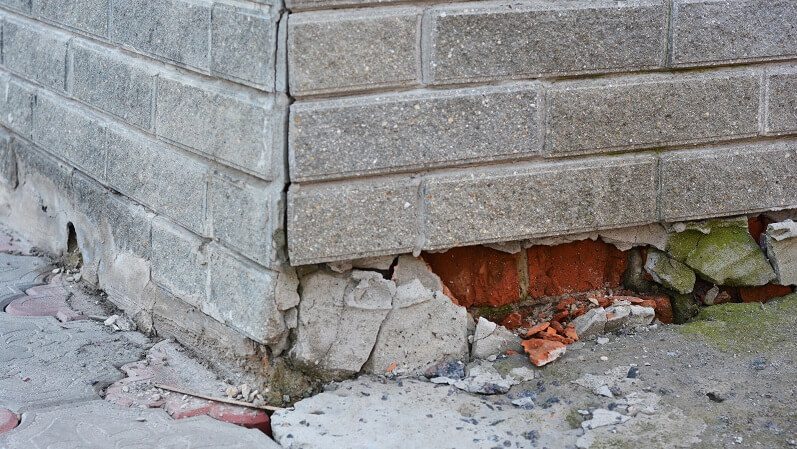
The condition of every single home relies on the strength of the foundation beneath it and the shield of the roof above it. When a roofing system fails, often the first sign of trouble is a wet spot on your ceiling. So it is with your home’s foundation. When your concrete slab is no longer holding your home perfectly steady, walls and floors can begin to move, causing doors and windows from properly opening and closing, drywall to crack, or your siding to crumble and peel away from your home. More than visible markers, these problems are often the first sign that something is wrong with your home’s foundation.
One, if by Land: Unstable Soil and Shifting Foundations
Your home may seem immovable, but in fact, it’s vulnerable to the immense forces of the Earth beneath it. Geological events can make even sturdy, well-built homes seem like sand castles or cardboard cutouts. Soil erosion, shifting land masses, and sinkholes underneath your home are not things that can be easily prevented, but it is something to carefully watch out for. Quickly identifying problems with your home and having them checked out can reduce the cost of these surface repairs and the cost to fix the foundation itself.
HomeAdvisor compiles data on homeowner service requests for each major U.S. city, including foundation repair. Some of the cities known for their loose soil, landslides, and damage to residential foundations include Atlanta, Dallas, Washington D.C., Los Angeles, Minneapolis, Cincinnati, and Pittsburgh. That said, just because you don’t live in one of these cities doesn’t mean your home is safe from “slow landslides” and eroding topsoil. Likewise, just because you do live in one of these cities don’t necessarily mean your home’s foundation is under eminent threat of damage. If your house showing signs of movement, such as windows, doors, drywall, or siding damage, you should probably have someone look at your foundation for signs of trouble.
Two, if by Sea: Water Damage and Lawn Drainage
A perfect catch-22, while homes on severely sloped lots tend to be susceptible to landslides, homes on relatively flat lots tend to be susceptible to sitting water and inadequate lawn drainage. Gutter damage, poorly designed downspouts, and/or the inability of your lawn to divert water, can cause water to surround your foundation. This can, in turn, lead to basement flooding, soil erosion, and freeze/thaw cycles that can actually cause cracks in your concrete slab. Water damaged foundations tend to create even larger headaches than those of slow landslides, but water damage is also more easily preventable. So long as you keep up on your guttering system in good working condition, get semi-annual roof inspections, and watch out for the build up of water on your lawn after a heavy rain, chances are you’ll be able to identify and fix problem areas before they fester into costly damage.
Ready to start your Foundation Repair?
Find ProsIf your home is on uncommonly flat terrain, you may some trouble keeping the water off your lawn and away from your foundation. Installing a drainage system isn’t difficult but finding out where this water can be diverted is often a bigger issue. You can’t simply point a trench drain at your neighbor’s lawn. Local governments also tend to be reluctant about letting you divert your rainwater runoff into a municipal sewer system. As a final resort, you may need to dig and install a dry well that will send your runoff into the groundwater. Installing a dry well requires securing a building permit from state of federal environmental agencies.
Fighting Back: Mudslinging
Actually, the professionals call it mudjacking. Regardless of what initially caused problems with your home’s foundation, the ensuing expansion, contraction, or compaction must be dealt with. The foundation should be raised or altered to its original specifications, but mudjacking is what helps keep it there. This process involves pumping soil-cement using low-pressure hydraulics to ensure the soil-cement will properly fill the voids beneath your foundation. Another method of foundation repair is called piping or piering, a technique that uses steel pipe reinforcements to salvage failed home foundations.
Foundation repair is far from an exact science. Based in Dallas, TX, Brown Foundation Repair, an industry leader, gives this advice to homeowners, “If you ask five different companies for an opinion, you are likely to get five different answers and conclusions.” You should look for someone who evaluates “the entire problem, analyzing each piece of the picture, then custom designing a solution that best corrects the problem.”
A Chain of Events: Getting Back to the Foundations of Home Maintenance
The American Revolution wasn’t started in a day, and your door didn’t come out of its jamb overnight. If you haven’t yet internalized a sense of urgency, here is the nightmare scenario, waiting for homeowners who neglect their homes year after year: Your bedroom door begins sticking. You call in a handyman who fixes the problem. A year later, your bedroom and bathroom doors are both sticking. This time, a contractor comes out to your home to fix the doors and tells you that your foundation is sinking. The foundation contractor comes out and fixes your foundation and explains what the problem was – a downspout wasn’t positioned far enough away from your home. A small aluminum chute needed to be placed three feet further out for your home, and it’s now cost you $10,000 in total repair costs. Whether it’s a door or window, cracks in your drywall, or water on your lawn, at the first sign of trouble, you absolutely must get a qualified contractor out to your home.
 Going Green: Foundation, Retaining Walls & Waterproofing
Going Green: Foundation, Retaining Walls & Waterproofing  How to Spot & Repair a Sinking Foundation
How to Spot & Repair a Sinking Foundation  Repairing a Cinderblock Foundation – Common Issues
Repairing a Cinderblock Foundation – Common Issues  Cracked Foundation
Cracked Foundation  Sealing a Foundation
Sealing a Foundation 

Are You Familiar With This Topic? Share Your Experience.